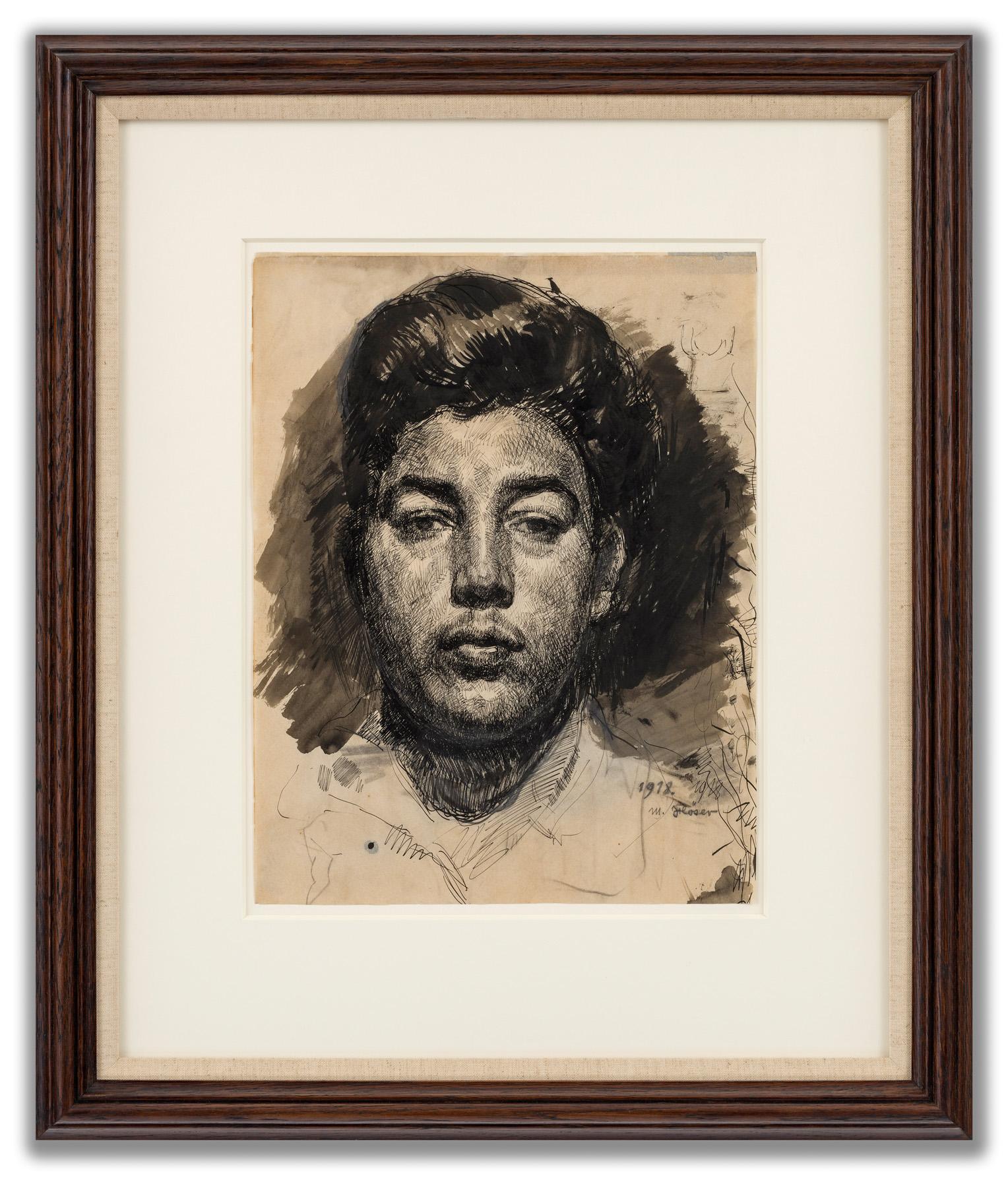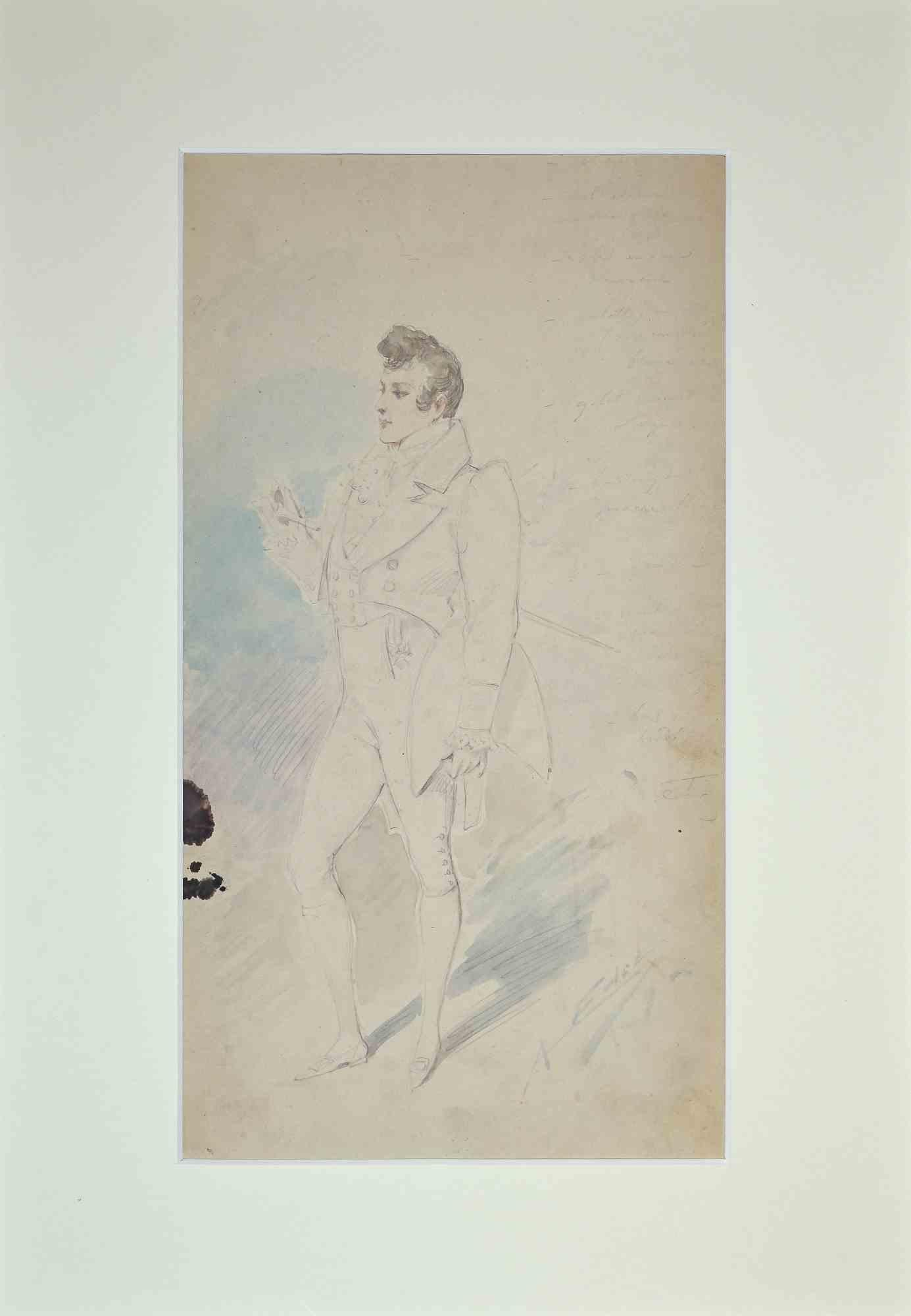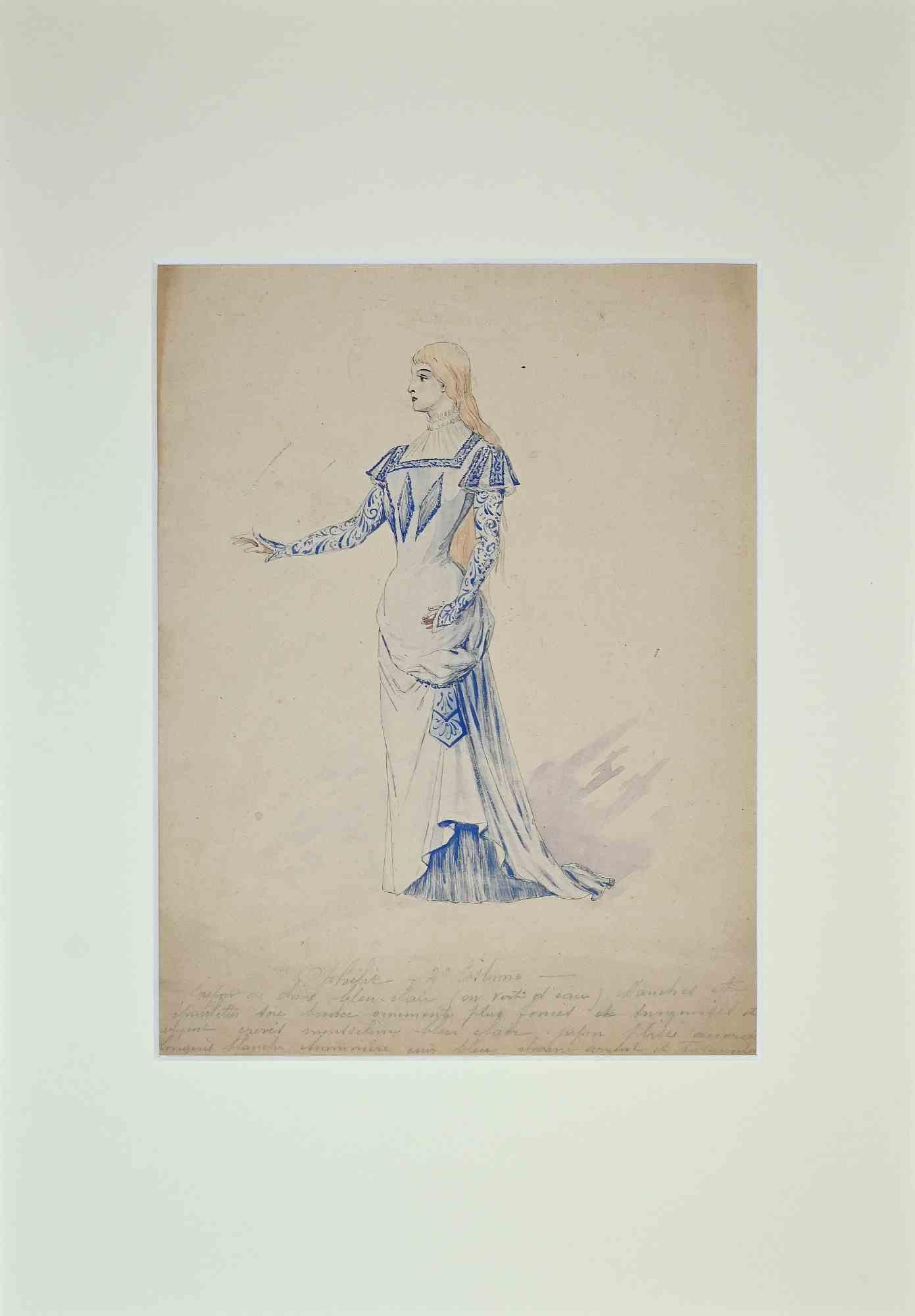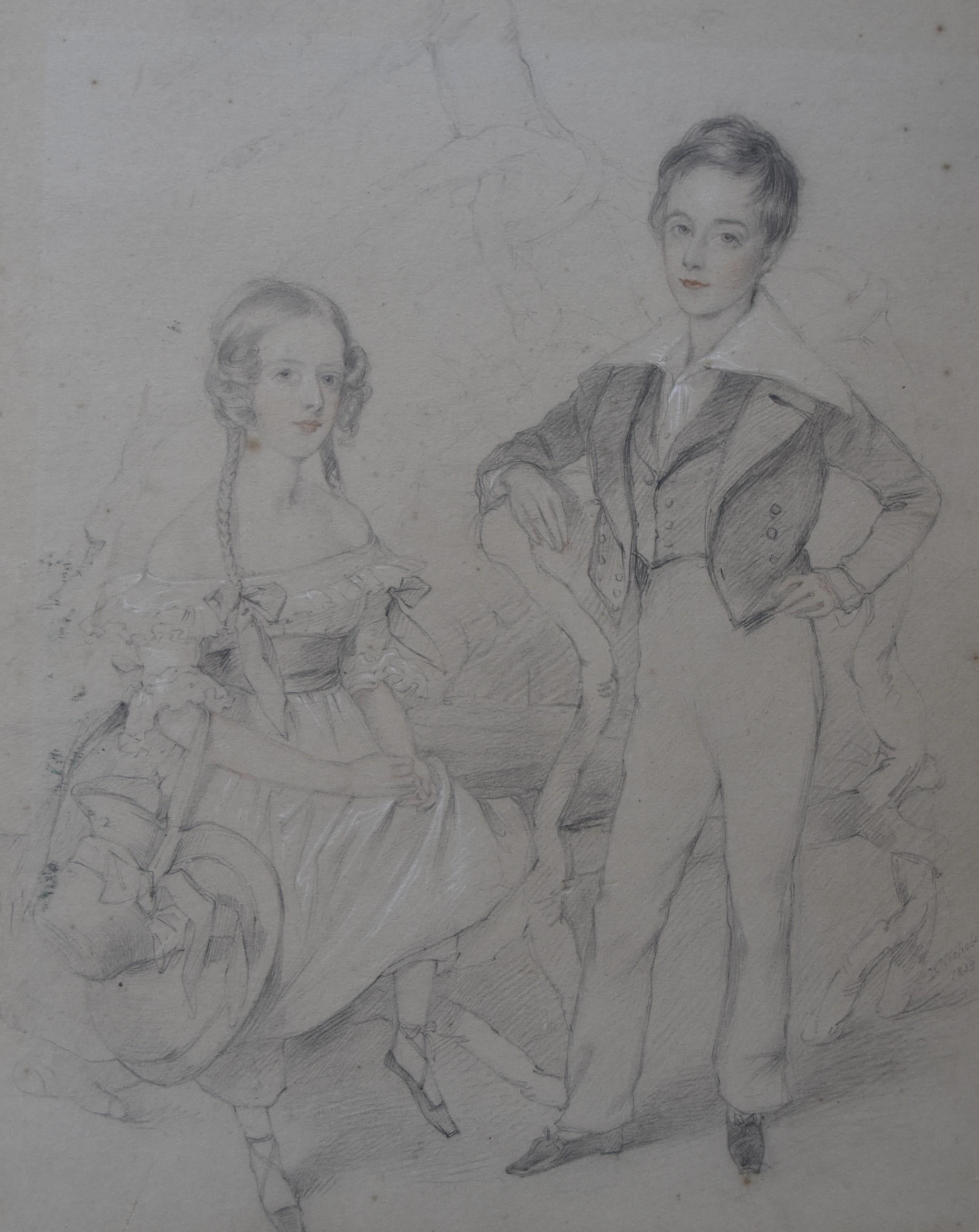George Romney18th century ink study for the Leveson-Gower Children1776
1776
About the Item
- Creator:George Romney (1734 - 1802, English)
- Creation Year:1776
- Dimensions:Height: 7.5 in (19.05 cm)Width: 4.75 in (12.07 cm)
- Medium:
- Movement & Style:
- Period:
- Condition:Drawing in excellent condition, the ink remains very strong.
- Gallery Location:London, GB
- Reference Number:1stDibs: LU150727730282
George Romney
George Romney is best known as one of British society’s foremost portrait painters of the 18th century, rivaling other widely acknowledged portraitists such as Thomas Gainsborough and Joshua Reynolds.
Born in 1734 in Dalton-on-Furness, Romney was the son of a cabinetmaker. In 1755, he began his artistic career as an apprentice to portrait painter Christopher Steele before traveling to northern England to establish a painting studio in Kendal. Romney’s talent in portraiture proved fruitful. By 1762, he had made enough money to set up a studio in London, where he became renowned for an “ability to paint flattering images regardless of personality.”
During the 1760s, Romney had hoped to become a history painter but was unsuccessful. To refine and improve his technique, he traveled to Rome in 1773, where he spent two years studying the Old Masters, including Titian, Correggio and Raphael. While there, he was also influenced by the works of Swiss painter Henry Fuseli.
Upon his return to London, in 1775, and with his newly honed painting style, Romney became even more popular among the British aristocracy and nobility. Although his primary aspiration was to make a living as a historical painter, Romney was in demand as a portraitist. His favorite subjects were children and women, particularly his muse, Emma Hart — who later became Lady Hamilton and mistress of Admiral Lord Nelson. Romney painted several Romantic portraits and drew many sketches of Lady Hamilton, whom he considered to represent the ideal of feminine beauty.
In his later years, Romney produced several portraits and drawings of Shakespearean subjects for John Boydell’s Shakespeare Gallery in 1790.
Romney’s figurative works, portraits and prints are held in collections of numerous major museums and galleries, including the National Portrait Gallery in London, the National Gallery of Canada in Ottawa, the Metropolitan Museum of Art and the Frick Collection in New York. In 2002, an exhibition commemorating the bicentenary of Romney’s death was organized by the National Museums Liverpool in partnership with the National Portrait Gallery and the Huntington Library, Art Collections and Gardens in San Marino, California.
On 1stDibs, find a range of original George Romney drawings, paintings and prints.
- ShippingRetrieving quote...Ships From: London, United Kingdom
- Return PolicyA return for this item may be initiated within 14 days of delivery.
- 18th century portrait drawing of the Rev. William AtkinsonBy George RomneyLocated in London, GBCollections: Henry Scipio Reitlinger (1882-1950); Private collection, UK to 2019 Framed dimensions: 14.50 x 15.38 inches This drawing is one of only two known portrait drawings by Romney (as opposed to preliminary studies for portraits) and is dated by Alex Kidson as being executed no later than 1769. It is likely that the present drawing was originally part of a sketchbook, now largely dismembered (Abbot Hall Art Gallery, Kendal), which Kidson notes, contained some of Romney’s most beautiful early drawings. This drawing, and a second sheet formerly with Andrew Wyld, have been identifying as depicting the Rev. William Atkinson...Category
18th Century Old Masters Portrait Drawings and Watercolors
MaterialsPencil
- Portrait drawing of Harriot Mellon, Mrs Thomas CouttsBy Henry FuseliLocated in London, GBInscribed by the artist in pen and brown ink, upper margin: 'σοφὴν δὲ μισῶ: μὴ γὰρ ἔν γ' ἐμοῖς δόμοις / εἴη φρονοῦσα πλείον' ἢ γυναῖκα χρή [Euripides, Hippolytus, 11, 640-41: “But a ...Category
19th Century Old Masters Portrait Drawings and Watercolors
MaterialsPencil
- Regency portrait drawing of Arabella Graham-ClarkeBy John DownmanLocated in London, GBCollections: The sitter, and by descent; Christie's, 19th March 1928, lot 6; Private collection to 2019 Literature: G.C. Williamson, John Downman, A.R.A., his Life and Works, Lon...Category
Early 19th Century Old Masters Portrait Drawings and Watercolors
MaterialsWatercolor, Pencil
- Regency portrait drawing of Lady NugentBy John DownmanLocated in London, GBCollections: With Ellis Smith, London; Private collection, to 2015. Literature: G.C. Williamson, John Downman A.R.A., his Life and Works, p. lviii no...Category
19th Century Old Masters Portrait Drawings and Watercolors
MaterialsWatercolor, Pencil
- Portraits of the Hon. Mary Shuttleworth and Anna Maria, 9th Baroness ForresterBy Daniel GardnerLocated in London, GBTHE HON. MARY SHUTTLEWORTH, NÉE COCKBURN (D. 1777) and her sister ANNA MARIA, 9TH BARONESS FORRESTER (D. 1808) Pastel and gouache on paper laid on canvas, on their original backb...Category
18th Century Old Masters Portrait Drawings and Watercolors
MaterialsGouache, Pastel
- Eighteenth-century Irish portrait of the Rev. Henry DabzacBy Hugh Douglas HamiltonLocated in London, GBPastel on paper, oval 9 x 7 ¼ inches; 230 x 185 mm Inscribed on the verso: ‘The Revd Henry Dabzac D.D./ late Senior Fellow of/ Trinity College Dublin/ ever to be lamented by all that knew/ Him. Extensive learning, zeal, gently tempered/ by a spirit of charity & above all, a strong/ faith & a piety deservedly gained/ the character of a great and good man./ This exceptional man died 12th May 1790/ This picture was his give to Jane [Mary] Crofton, his sincerely [missing] sister.’ Collections: Rev. Dr Henry Dabzac gift to his sister, Jane Crofton (d.1797); Sir Hugh Crofton (1763-1834); By descent to 1990; Private collection, Dorset to 2020. Literature: Robert Staveley, Traces of Past and Present, Dublin, 1895, p.74; Neil Jeffares, Dictionary of Pastellists Before 1800, online edition, no.J3751247 This characteristic pastel portrait by Hugh Douglas Hamilton was made early in his career; it depicts precisely the kind of education, well-connected Irish sitter who fuelled his success. The Reverend Henry Dabzac was from a distinguished Huguenot family, a celebrated academic historian, Dabzac received the Donegall lectureship in 1764 and from 1785 was Librarian and Senior Fellow of Trinity College, Dublin. According to his earliest biographer, Hamilton was the son of a peruke-maker based in Crow Street, Dublin. As Anne Hodge has pointed out, this places Hamilton’s father at the heart of the city: Crow street was a narrow thoroughfare formed part of the busy warren of streets bordered by the old Houses of Parliament and Trinity College at one end, and by Dublin Castle at the other. It is perhaps telling that in this early portrait, Hamilton shows Dabzac in a splendid powdered wig and his clerical bands. In 1754 Hamilton was apprenticed to James Mannin, a ‘pattern drawer’ who two years later was appointed master of the school of ornament at the Dublin Society’s drawing school, run by Robert West. Here Hamilton took the first prize in the 1755 competition, winning a premium of £1/16/. Hamilton developed a popular and profitable method of making pastel likenesses of sitters in a distinctive oval format. Hamilton developed a technique of using a sharpened pastel to hatch shaded areas of the features and, in the case of this portrait of Dabzac, the white powdered wig, which is drawn with particular care. In 1764 Hamilton moved to London where this small, oval pastels proved...Category
18th Century Old Masters Portrait Drawings and Watercolors
MaterialsPastel
- Self PortraitLocated in London, GBPen and ink, ink wash and pencil on paper, signed and dated (lower right), 38cm x 29cm (65cm x 55cm framed). This penetrating and wonderfully executed self-portrait, is all the mor...Category
1910s Old Masters Portrait Drawings and Watercolors
MaterialsPaper, Carbon Pencil, Ink
- Jean-Henri Cless (1774-1812) Portrait of a young woman, signed drawingLocated in Paris, FRJean-Henri Cless (1774-1812) Portrait of a young woman in a landscape signed "Cless fec" for fecit on the lower left Brown ink and brown ink wash on pencil Size of the sheet : 31.5 x 22 cm Size of the motive : 24.5 x 17 cm very simply framed under glass without actual frame 32 x 22.5 cm This pre...Category
Early 1800s Old Masters Portrait Drawings and Watercolors
MaterialsInk, Pencil
- St. John the Baptist in the wilderness , Ecce Agnus Dei (Behold the Lamb of God)By Giovanni Francesco Barbieri (Il Guercino)Located in Middletown, NYPen and sepia ink and wash on vellum, 8 7/8 x 10 1/2 inches (225 x 267 mm). In very good condition with some modern notations in pencil on the verso, minor cockling, and a 1-inch hor...Category
Mid-17th Century Old Masters Portrait Drawings and Watercolors
MaterialsInk, Watercolor, Vellum, Pencil
- Theatrical Costume - Pencil Drawing by Alfredo Edel - 1895By Alfredo EdelLocated in Roma, ITTheatrical Costume is an original pencil, pastel and watercolor drawing realized by Alfredo Edel in 1895. Good condition, the artwork is with watercolor and biacca. Hand signed with pencil by the artis. Alfredo Leonardo Edel (1856–1912), sometimes credited as Alfredo Edel Colorno, was an Italian costume designer popular during the late 19th and early 20th century. He worked at the La Scala opera...Category
1890s Old Masters Figurative Drawings and Watercolors
MaterialsPastel, Watercolor, Pencil
- Theatrical Costume - Watercolor by Alfredo Edel - 1895By Alfredo EdelLocated in Roma, ITTheatrical Costume is an original pencil, pastel and watercolor realized by Alfredo Edel in 1895. Good condition, the artwork is from Amleto and represents Ofelia, with a note writes from the artist on the lower margin. Hand signed with pencil by the artist. Alfredo Leonardo Edel (1856–1912), sometimes credited as Alfredo Edel Colorno, was an Italian costume designer popular during the late 19th and early 20th century. He worked at the La Scala opera...Category
1890s Old Masters Figurative Drawings and Watercolors
MaterialsWatercolor, Pastel, Pencil
- English School early 19th century, Portrait of two children, drawingLocated in Paris, FREnglish School early 19th century, Portrait of two children, Pencil and light heightenings of white and red gouache 29.5 x 23 cm In quite good condition : the pape is yellowed by time and there foxings and stains visible (please refer to the photographs) In a vintage frame (some minor damages) : 48.5 x 38 cm This charming drawing of children is typical of English portraiture as it had its heyday shortly before with Reynolds and Gainsborough. The codes required, for example, that the female sitter...Category
Early 1800s Old Masters Portrait Drawings and Watercolors
MaterialsPencil






